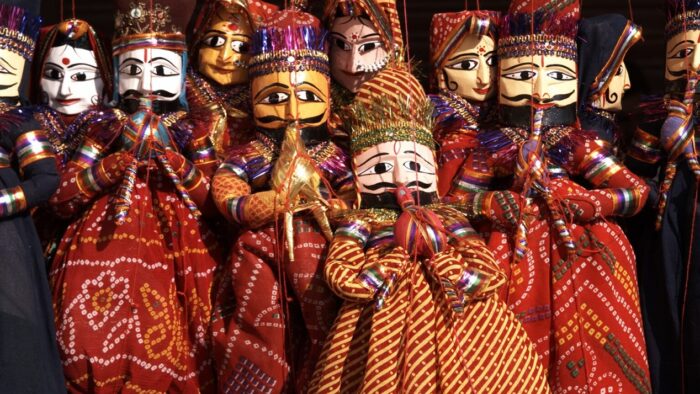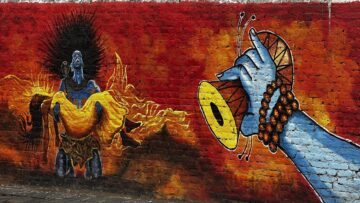In many ways, the Indic civilization is represented by the ‘Katha’—the Story. Every civilization evolves its own storytelling tradition and crafts a story house. Civilizations tell stories to themselves in order to strive for continuity in the face of change over time. Stories become a repository of Thought-complex and Experience-complex from which to draw inspiration for the Present and the Future. Stories give assurance to the young that there is a meaningful and productive Past behind them from which they can draw the Future. While this is true of all civilizations, there is something very different about the storytelling traditions of India. The fact that we use ‘traditions’ in the plural says it all.
A storytelling tradition is a function of the following
- The Thought-Complex and the Tradition of the Community
- The Experiences of the Present
- The Creativity of the Individual and the Community
Communities within a civilization often share a Thought-complex, yet every community develops its own layer around it. The experiences of one community are very different from those of another by definition in India. Communities have evolved with their own professions/occupations, geography, interrelationships/conflicts alongside other communities and the need to reside together over the course of Time. Each community has different forms of access to the material and the spiritual. The Kaala, Desha, and Vartamaana of each community differ. There are as many different storytelling traditions as there are communities. It is only to be expected that in a community-rich civilization such as Bharatavarsha that the indigenous storytelling traditions are innumerable. In addition, in our civilization,as the storytelling tradition becomes sophisticated, entire clans (Kulas) or communities (Jati-s) have dedicated themselves to storytelling and anchored themselves geographically around multiple communities. Some traditions have evolved to become thought of a ‘classical’—serving all communities from an altogether higher plane.
A storytelling tradition distinguishes itself through the following elements:
- Who tells the Story?
- Who is the Story told to?
- Why are those Stories told?
- What are the different kinds of stories told?
- What is the medium of Storytelling?
- How are the stories passed on from one generation to another / What is the mode of story preservation?
- What are the artistic elements/forms used in Storytelling?
- What are the physical instruments used to tell the Story?
- What are the aesthetic concerns shaping the Storytelling?
- How has the Storytelling shaped the Community?
- What is its larger impact and unique contribution to Storytelling itself or the artistic world?
Over the last 300 years we have moved quickly into a Modern World shaped by Colonialism and Industry. In this process, we have managed to retain some traditions and lose others—this applies not only to storytelling but also to other aspects of our civilization. While we do not need to lament over what is lost, it is time to understand the strengths of our storytelling traditions and explore ways and means of retaining them in the modern world. It is important to recognize that what once depended on a community is difficult to maintain in an individualized world. Yet, the modern world has created new mediums for storytelling. It is our challenge to bring the strengths of our past into the future—for ourselves and the world. To be able to tell a story represents confidence in our own selves and civilization. To reclaim storytelling traditions is to reclaim the civilization itself.
Indigenous storytelling traditions can be of two types.
- Folk: extensive research carried out throughout the world on the topic of stories, storytelling, narratives, narration, etc., in the field of folklore/folk culture studies and culturalanthropology
- Classical: the study of classical languages including Sanskrit and other Indian classical literatures and classical performing and other fine arts.
Within this broad spectrum lie innumerable forms such as Panchatantra, Kathasaritsagara, Purana-Pravachana, Katha-Kalakshepa, Yakshagana, Burra-Katha, puppet shows and so on. An exhaustive listing would run into pages. It is time to bring them back centre stage and imagine a future in their light.
INDICA is pleased to organize a conference on “Indigenous Storytelling Traditions of India”. We invite papers from researchers, performers and cultural connoisseurs. We are eager to receive papers in the following areas.
- Studies on Storytelling Performing arts
- Studies on Storytelling Informal event genres like bedtime/ granny’s storytelling events etc.
- Studies on Narrative techniques in the oral and written folk and classical texts, including texts of narrative collections with different structures of compilation
- Studies on Narrative structure narrative/story (as distinguished from narration), itivritta nirmaaNa, plot structure
- Studies on Narrative types/narrative genres etc., tales, tale types, tale motifs, narrative types like myth, legend, folktale and fairy tale etc.
Our diversity results in a rich set of contexts. Indian tradition has evolved both universal and contextual forms of storytelling, resulting in a very rich Katha-Kathana-Paddhati. Entire communities participating in and receiving these stories result in complex, layered, stories within stories that then become civilizational memories. The highly complex yet flowing form of storytelling we see in Gathasaptashati/Kathasaritsagara is an example of the compilation and narration techniques Indian storytelling tradition has evolved. The fluid nature of the difference between the Narrator and the Actor and the presence of multiple narrators within the same storytelling performance demonstrate the sophistication of our forms and techniques—these elevate the receiver and make one part of the flowing story. Such richness in narrative performance, narrative instruments! Why do we have such diversity? Where does this diversity come from? We seek answers to these questions from the papers of this conference.
It is not that these questions have not been raised before. International societies (for instance, theInternational Society for Folk Narrative Research) interested in storytelling cultures have carried out extensive studies and published both academic papers and illuminating books. However, the question is, Do they sufficiently mirror Indigenous Storytelling traditions of India? Have they truly understood our rich forms? If not, what is the work that lies ahead of us? Why are the international repositories not aligned with ours? Why is Western research not able to grasp Indian storytelling perspectives? We hope to seek answers to these questions as well as comparative perspectives with a global mindset. We should be able to answer questions such as, Why do Indian puppet shows represent our classical/folk mythology, while in the west mythology is devoid of such folk representations? Why are our granny stories so different?
We hope to find answers to these questions at the Conference.
Call For Papers
We invite practitioners, scholars, researchers, and connoisseurs to present Indigenous Storytelling Traditions of India from various perspectives, outlined above.
The Conference will be curated by Dr Nagaraj Paturi, Senior Director of INDICA, and co-curated by Deepa Kiran, well-known Storyteller and an educationist, and Shivakumar GV, Consulting Editor for Indica Today.
Submission of Abstracts
Abstracts of 300 words (font size 12, Times New Roman, 1.5 line spacing) must be sent by email to namaste@indica.org.in with the title of the Conference mentioned in the subject. Abstracts should provide a brief description of the topic and, if required, the theoretical focus, objectives, study area, and research methodology. Acceptance of the abstract will be notified to the author.
Please note the following.
- The Conference is scheduled for 7th and 8th January 2022.
- Please send your 1 Page Abstracts for the Conference by 7th December 2021.
- Please send your final version of the Paper by 31st December 2021.
- Please send all communications to namaste@indica.org.in
Originally announced here
Disclaimer: The opinions expressed in this article belong to the author. Indic Today is neither responsible nor liable for the accuracy, completeness, suitability, or validity of any information in the article.





